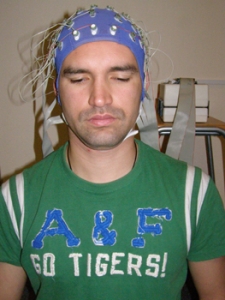Our Research
Meditation and the research behind it
Our approach to meditation research
Meditation, mindfulness and contemplative practices are varied and influence a wide range of human experience, body and behaviour. Accounting for this richness the remit of our research is broad, with an interdisciplinary multi-method perspective. Rather than compartmentalising our research along traditional discipline boundaries, we consider how evidence from different fields and different methodologies converges and improves our scientific understanding of meditation and mindfulness. As the personal experience of meditators and the insights of previous meditation masters provide important first person data – immediate as well as codified into whole meditation systems – we think that the collaboration with experienced practitioners, with Buddhist scholars and with experts representing specific meditation traditions provides additional depth to our research.
Our research projects provide glimpses of what meditation does to our body, our brain and our mind – parts of a large puzzle that over time will become more and more complete. In general, we use four main approaches in this endeavour.
OUR RESEARCH
Pieces in a puzzle
Cross-sectional comparisons
We compare meditators with non-meditators, meditators with different levels of experience on various parameters, including behavioural performance and neurophysiological parameters. Although such studies do not tell whether group differences are causally linked to meditation practice, they indicate what may improve as a result of meditation. If, furthermore, we find that a specific parameter co-varies with meditation experience (for example: the more meditation experience a participant has the better they would tend to perform on the task), a possible causal role of the mind training may be carefully considered. Such cross-sectional investigations are often a useful first step to confirm that the chosen parameters and outcome measures are promising. For instance, if we are interested in the effects of meditation on cognitive performance, but find that meditators do not perform better than non-meditators on the chosen cognitive test, most likely, it will not make sense to use such cognitive test in far more expensive and time-consuming longitudinal studies.
See for example: Moore & Malinowski (2009) or Jo, Malinowski & Schmidt (2017).
Correlational studies
In a second, related approach we consider dispositional mindfulness (also called ‘trait mindfulness’). Participants complete scientifically validated mindfulness questionnaires which indicate how mindful somebody is in daily life, irrespective of any meditation experience and sometimes even without explicit knowledge about mindfulness per se. For each participant the questionnaire yields an estimate of their level of mindfulness. We then investigate whether there is a statistical relationship with other parameters, for example performance in cognitive tests, or also indices of brain function. The assumption here is that mental functions that are positively linked to dispositional mindfulness might benefit from mindfulness practices that aim to raise levels of dispositional mindfulness. However, as is the case for cross-sectional group comparisons described above, also such correlational studies cannot offer direct evidence for causal links between mindfulness and the parameters under investigation. As before, such studies can only be seen as a first step, a preparation for longitudinal studies.
See for example: Lattimore, Fisher & Malinowski (2011), Malinowski & Lim (2015) or Lattimore, Mead, Irwin, Grice, Carson & Malinowski (2017).
Experimental mindfulness inductions
In a third approach, we invite participants to the research lab and use specific experimental inductions with the aim to temporarily increase their levels of mindfulness. This may sound fancy, but in most cases it merely means to guide the participant through a mindfulness meditation practice. The assumption is that after such an induction participants are more mindful than before, often confirmed through the use of brief state mindfulness questionnaires. We then investigate whether behaviour, performance or internal experiences change when people are in a more mindful state. Because the mindful state is manipulated experimentally, this approach allows us to draw conclusions about potential causal mechanisms, i.e. how being mindful influences other process. For example, one of our studies showed that people tend to eat fewer cookies after their state mindfulness increased. The specific design of the study even allowed us to conclude that this reduction in “cookie intake” was not because of paying more attention to food, but actually because of the mindful attitude while paying attention. You can read the details of the study here: Fisher, Lattimore & Malinowski (2016).
Randomised controlled studies
… are the gold standard for studying the effects of any form of training, including meditation. Such longitudinal studies investigate changes that occur when people meditate for a while. This scientific approach allows us to establish causal links between meditation training and the functions and factors of interest. Changes over time are investigated by randomly allocating participants to meditation training or to an active control group. The participants in the active control group engage with activities that are as similar as possible to meditation without actually being meditation. To some extent, this can be compared to a placebo in medical research. This control condition is necessary to rule out other influences than meditation itself that may cause the observed changes, such as life style changes or the mere fact of doing something new. While crucially necessary for studying the effects of meditation, practical limitations of these longitudinal studies need to be acknowledged, too. Consider, for instance, the study by Brefczynski-Lewis et al. (2007), who investigated attentional functions in groups of meditators with estimated lifetime meditation experience of up to 44,000 hours of meditation practice. A time span of around fifteen years would be required to build up this level of expertise, if investing eight hours per day, a target that even for an exceptionally well-funded longitudinal study would be difficult to achieve.
Examples of such longitudinal randomised controlled studies are for example: Moore, Gruber, Derose & Malinowski (2012); Malinowski, Moore, Mead & Gruber (2017); Schöne, B., Gruber, T., Graetz, S., Bernhof, M., & Malinowski, P. (2018); Pozuelos, J. P., Mead, B., R., Rueda, M. R., & Malinowski, P. (2019).
Theoretical work
In addition to these empirical approaches we also consider theoretical positions, integrate findings across studies and discuss the wider implications of meditation research. Examples of such theoretical papers are: Malinowski (2008), Chiesa & Malinowski (2011), Malinowski (2013), Malinowski (2017), or Malinowski & Shalamanova (2017).

